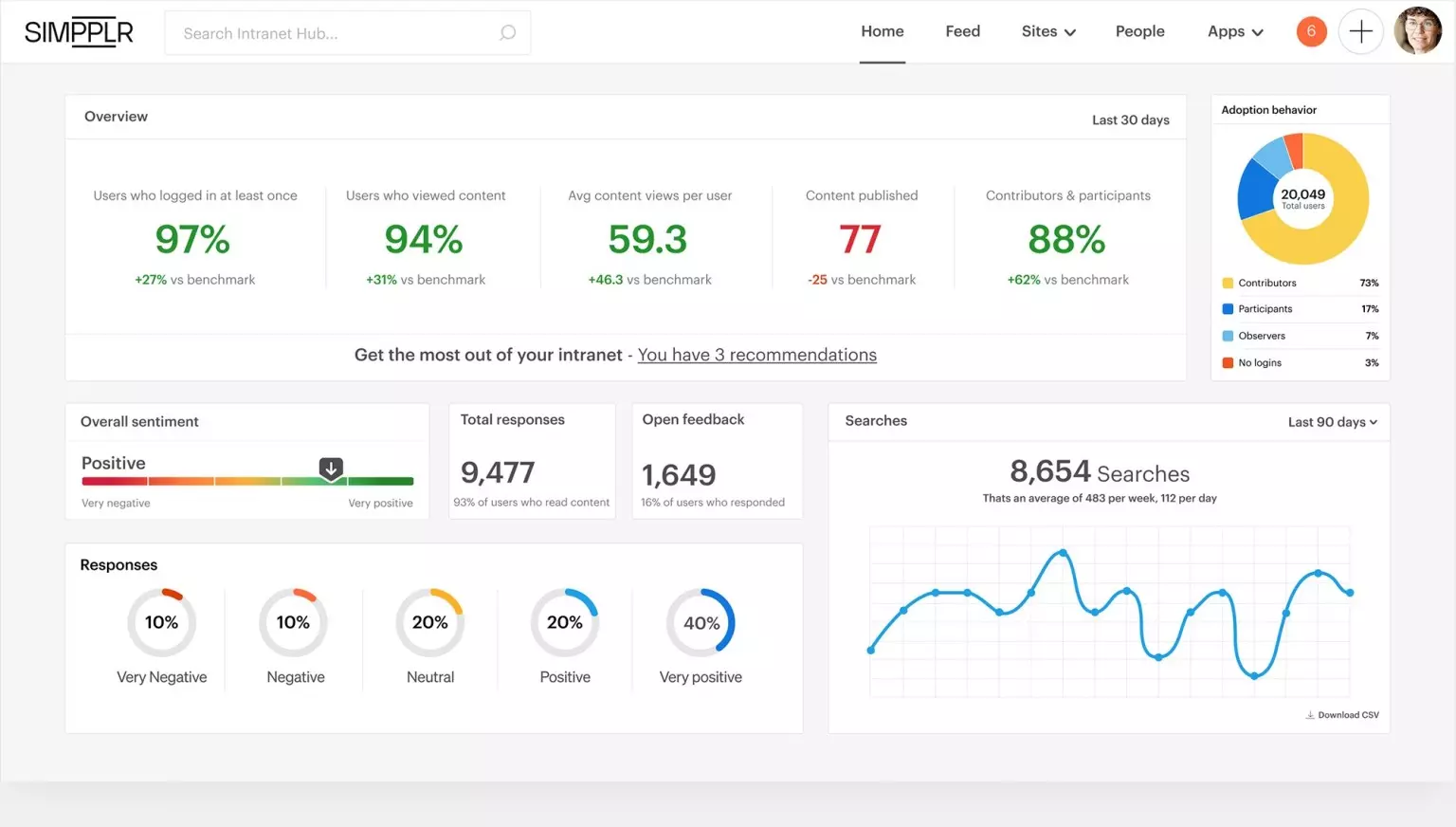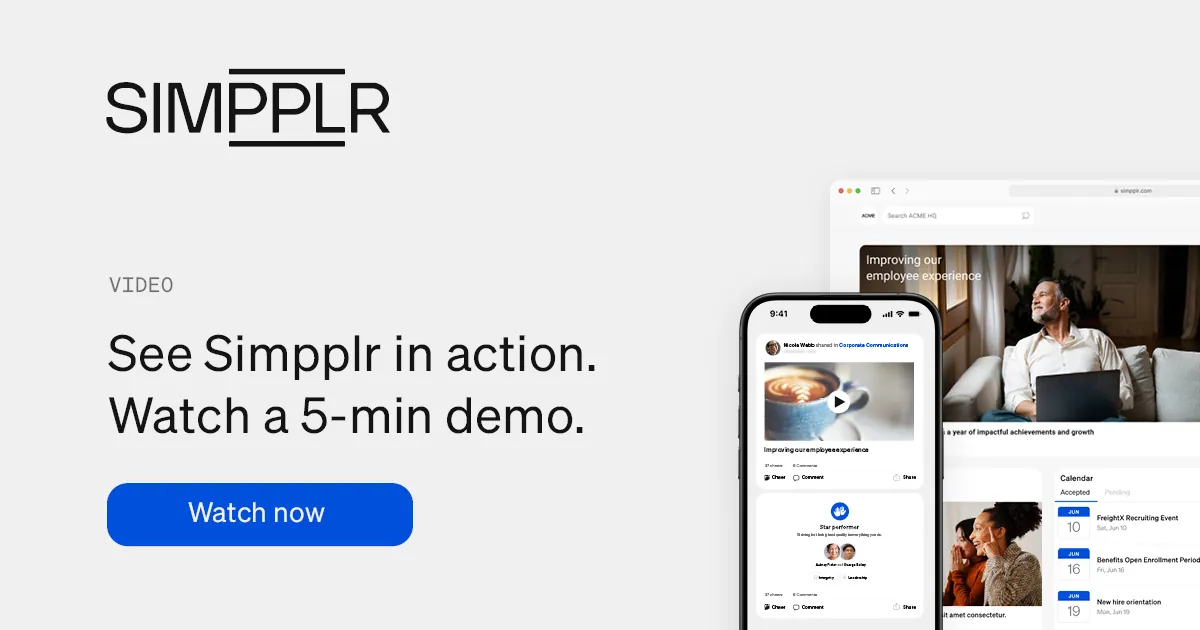Good internal communication is essential in every organization. Whether you have a dedicated internal comms function or not, it’s vital to have an efficient method for disseminating and managing employee communication. Oftentimes, we hear internal communications as a departmental function. But really, internal communication is about sharing and instilling critical information among people so that they can perform at their best.
When internal communication is poorly managed, challenges emerge. One of these challenges is a lack of employee engagement—and this affects productivity, which has a direct impact on your bottom line. In many companies, poor internal communications are a vicious cycle that plays on repeat: When employees aren’t engaged, they don’t read company communications. If they don’t read company comms, you can’t reach them to improve employee engagement.
How can a dedicated comms team break the cycle and improve internal communications? It isn’t always easy, but our internal communications best practices can help you hone your IC strategy, reach your audience, and boost employee engagement.
What is internal communication and why it matters
Good internal communication is the cycle that holds employees together from the top down. Employees feel lost and disconnected from their companies when they don’t understand their purpose. This is where the internal communication role has the most significant impact on a company.
Internal communication aims to deliver an employee experience (EX) that connects, aligns, and engages everyone. And all internal communication should tie back to this purpose.
Put succinctly, internal communication is how information is transmitted between members of an organization and across all levels and departmental lines.
How to improve internal communication within the department
First, we need to take a step back and focus on the types of internal communication that is being permeated throughout an organization. Here are some questions to ask yourself if you’re evaluating your internal communications:
- Are your internal communications purposeful?
- Do key messages reach your entire company?
- Are your efforts improving employee engagement?
- Is executive messaging communicated clearly?
Next, focus on departmental goals. A common goal is to increase employee engagement or improve company culture. These two go hand-in-hand. If you think about it, employees make up the culture that is defined by leadership.

It is best practice to improve internal communication within a department by leveraging the three key drivers that have been shown to impact employee engagement (and subsequently culture):
- Purpose. Always set the purpose. Make sure that every employee in the internal communications understands the purpose of the department. Purpose gives employees inspiration to do their best work, motivation to push through challenges, and most importantly gives them a reason to be excited to go to work every day. When you solidify the purpose of the department, employees are far more likely to be more productive and work better together to execute and hit goals.
- Alignment. If the internal communication department isn’t aligned, then how else is the entire organization going to be aligned? Alignment is making sure that employees and executives are on the same page and that everyone understands how their work is impactful. Always make sure that every internal communication employee understands the overall goals and strategy to maximize the impact of the department.
- Community. Focus the internal communication department to build a sense of community. Improving the internal communication function should take time to understand employee diversity and backgrounds so it’s able to foster a culture that makes everyone feel safe and connected.
Employee engagement depends on workers having a sense of purpose. When employees care about their company’s vision and mission for serving its customers and communities, they’re more engaged with the company and its work.
And don’t exclude leadership! Executives play a huge role in improving internal communications. They need to be involved because they set priorities and the tone of the overall organization. The internal communication function needs leadership and leadership needs internal communications to distribute critical information and engage employees.
Internal communication best practices & tips
All too often, understaffed comms teams struggle to meet a daily grind of last-minute information and tight deadlines. As a result, there isn’t much time to work strategically, and employee communications start to feel like a string of independent messages that aren’t telling a cohesive story.
These best practices can help you reconnect with that story, bring renewed energy to your work environment, and improve internal communications at its core.
1. Get laser-focused on your internal comms goals
Effective communication starts with a crystal-clear understanding of why you’re connecting with others. The content of your message might drive what you say, but your goals as an internal comms team need to drive how you say it.
- Are you trying to implement a company-wide digital transformation?
- Are you concerned about retention and employee morale?
Sculpt and improve your internal communications plan by identifying what you want to accomplish. Then, let that top-down purpose drive your decisions, from the stories you choose for your newsletter to the voice you use in writing them.
2. Align your internal comms strategy to what matters
Your internal communication success depends on getting leadership involved. Executives play a massive role in improving internal communications. They need to be involved because they set priorities and the tone of the overall organization. The internal communication function needs leadership, and leadership needs internal communications to distribute critical information and engage employees. While creating your internal comms strategy, ensuring alignment with company values is essential. Internal comms teams can do this with clearly defined messaging and objectives.
3. Develop your internal comms “brand” voice
Do you want to create a friendlier place to work? Do you want employees to feel more confident in company leadership? Let the goals of your internal communications strategy drive the voice of your communications. That voice exists in a symbiotic relationship with company culture. A “corporate” voice can feel distant, while a warm, empathetic tone is more likely to encourage team building, inspire confidence, and raise employee satisfaction.
4. Focus on the “customer”—your employees!
The most powerful communication skill you can foster in any comms team is listening. Meaningful conversations require two-way communication. This means opening up internal communication channels and getting to know your audience.
Use internal communication channels, from pulse surveys to in-person, face-to-face interviews to gather employee feedback. Another best practice is to consider scheduling regular employee feedback meetings. Ensure that you are creating an environment of trust and respect.
Encourage open communication by utilizing communication channels that make this possible if your internal communications software includes built-in prescriptive analytics and engagement tracking—even better! Use them to learn what engaged employees, specifically, as you want to hone your workplace communication to meet their interests and needs
5. Create an internal messaging guide

Excellent communication has a singular message at its heart. For your internal comms, that central idea might be “When one of us succeeds, we all succeed,” or “We’re strongest when every voice is heard and respected.”
Choose the heart of your message for your internal communication plan and think about that message as you choose your internal language, from the mission statement of your entire company to the tone of your monthly internal newsletter.
6. Balance fun, engaging content with critical information
Internal communications straddle the line between critical company information and fun, light-hearted content. On one hand, your job is to make sure the entire organization is clear of company priorities. On the other, you need to make sure that you’re engaging employees with what entertains them.
7. Craft internal messaging for each segment of your audience
Does your approach to communication change depending on whom you’re trying to reach? Walk through the various segments of your employee audience, from the leadership team and the workers on the line to in-office employees and remote workers, those approaching retirement, and brand-new hires. Company goals should be shared across every division. Remember that communication gaps will crop up if you don’t hone your messaging by job level, function, department, location, and longevity. Remember to pay special attention to new team members when integrating them into your corporate culture during onboarding.
8. Make sure your message is clear. Stress-test your content!
Think about your employees’ attention span – it’s not very long, especially when they’re riddled with their daily tasks. Use an active voice, engaging tone, and be direct. Videos are best to maximize engagement.
9. Develop your messaging cadence
Today’s corporate communication uses various communication methods: company emails, social media, employee apps, one-on-one meetings, and everything in between. Consider all your organization’s communication tools and available formats as you design your workflow. How often will you communicate, and how? For example, an employee newsletter might be monthly, while quick, fun posts might go out daily through internal social channels. Make sure, too, to think about timing employee notifications and surveys too, so that everyone can stay up with current projects without feeling overwhelmed.
10. Build out your internal comms calendar
Plan your calendar to share information around company meetings, performance reviews, quarterly reports, and other vital events affecting common goals across your team. Then, build out the rest of your calendar and add specifics. When will email newsletters go out? What important dates should employees be reminded about, and what form should those reminders take? Intranet posts? Slack alerts? Smartphone push notifications? As you design your strategy, remember to include informal communications too. Best practice on relationship building is remembering to check in regularly, even when you don’t need anything—especially when you don’t need anything.
11. Leverage technology to maximize your impact
Emails are proven to be ineffective for internal communication. Employees have cluttered inboxes that are filled with junk mail. In order to cut through the noise, you need technology to maximize your impact. For instance, technology that is purpose-built for important information – like a modern intranet. A modern intranet should be able to reach employees both using desktop and mobile.

Transitioning into the realities of today’s fast-paced environment, busy comms teams often struggle to find time for strategic initiatives. That’s why more and more teams use AI to streamline their workflows and maximize impact. Some of the ways they do this include:
- Syncing across communication channels like email, Slack, and SMS.
- Using proven, automated templates for fast, engaging newsletters.
- Creating media-rich employee experiences with native video.
- Honing their comms strategy with real-time analytics and metrics.
12. Include engaging images and video
When it comes to knowledge sharing, an image is worth a thousand words, and video is one of the best engagement channels a comms team could ask for. As you build your internal comms plan, remember to use a mix of media and content platforms. Memes can be a fun way to communicate company values, while infographics and training videos can help introduce new technologies for remote work, new benefits options, and more. You don’t need a graphic designer or professional actor on your team to branch out into visual media—you just need the right tools.
13. Make collaboration a core part of your strategy
You should foster a collaborative environment to deliver outstanding EX and reach your communication objectives. Promote cross-functional collaboration that helps employees perform better in their roles. Organize team-building activities that allow organization-wide interactions and facilitate the discovery of common interests. Provide opportunities for employees to develop their communication skills, such as offering them training workshops geared towards effective communication.
14. Share company priorities and progress frequently
What typically happens is, the company meets once a quarter and shares goals. From then on, employees forget priorities and end up with their heads down. This leads to employee disengagement and disconnection between employees’ daily tasks and company priorities.
15. Find out what employees are interested in
Leave your desk. Make new friends. It’s important to know the backbone of your organization so you can better understand diverse experiences and backgrounds. Use your new relationships and knowledge to create content that truly engages people.
You can also review analytics and insights within Simpplr to understand how employees and departments engage with your content across geos, and use those insights to make data-backed decisions on how to engage your employees best.

16. Don’t forget about distributed or remote employees!
The traditional workforce structure has changed drastically. It’s important to recognize and acknowledge that there are more distributed offices and remote employees across the globe. You’ll need to include them if you want to improve internal communication. Remember, the purpose of the internal communication department is to connect, align and engage the entire workforce. If the internal communication strategy isn’t doing that, it’s time to reevaluate your plan.
17. Incorporate effective communication into performance metrics
Develop methods for recognizing and rewarding effective communication. Providing incentives for proper communication will enhance your efforts throughout the company. You should find creative ways to recognize employees who excel in communication. And reward systems can help you translate effective communication into performance metrics. Internal communications efforts will resonate across teams as effective communication is identified and celebrated companywide.
Remember, the purpose of the internal communication department is to connect, align, and engage the entire workforce. If the internal communication strategy isn’t doing that, then it’s time to reevaluate your plan. If you’re looking for internal communication content ideas, download: The Definitive Intranet Content Playbook.
How Simpplr can help
Internal communications teams play a huge role in organizational well-being and require the right tools to develop and implement functional processes. Simpplr offers a unified, personalized, and frictionless employee experience that’s easy to implement.
We have a listener suite, and interactive knowledge-sharing capabilities, with real-time insights that make employee communication easy to develop, disseminate and manage across the organization.
Simpplr is purpose-built to build connection, community, and a cohesive culture to provide a framework for developing internal communication best practices and attaining your internal communication goals. Book a demo to see our employee experience platform in action.















